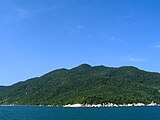The Cham Islands (Vietnamese: Cù lao Chàm) constitute a group of 8 small islands of Quảng Nam, which form a part of the Cu Lao Cham Marine Park, a world Biosphere Reserve recognized by UNESCO, in the South China Sea (East Sea) in Vietnam.[1] The islands are approachable from Cửa Đại beach. The islands are also recognized as Vietnam’s national scenic site.[2][3]
The islands grouped under the Cham Islands are: the Hòn Lao (Pearl), Hòn Dài (long), Hòn Mồ (tomb), Hòn Khô mẹ, Hòn Khô con (dry), Hòn Lá (leaf), Hòn Tai (ear) and Hòn Ông (east wind). The Cham Islands are under the administration of Tân Hiệp Commune of Hội An city in Quảng Nam Province.[4]
The occupation of the people of the islands is mainly fishing.[5]
Cu Lao Cham Islands’ ancient landscape offers many sand beaches, forested hills and the sea. Facilities for camping, swimming and scuba diving are available. The corals and marine life are an attraction in these island waters.[6]
Geography[edit]
Cu Lao Cham island group is a lower extension in SE of the granite block named Bach Ma – Hai Van – Son Tra belonging to the Hai Van complex of early Triassic age, mainly composed of biotite granite and two-mica granites [1].
The agglomeration of the one large island surrounded by seven small islands cover a sea area of 15 square kilometres (5.8 sq mi); located in South East Asia Sea, 16 kilometres (9.9 mi) from the coast and 19 kilometres (12 mi) to the east of ancient Hội An town.[3][7]
The largest island, circular in shape, has an area of 1,317 hectares (3,250 acres) with an average altitude of 500 metres (1,600 ft); the two peaks seen on the island are: one a 517 metres (1,696 ft) peak in the centre of the island and another 326 metres (1,070 ft) peak at the western end. On this largest island, the two fishing villages are Bai Lang, with docking piers, and the smaller Bai Huong.[6] Bai Chong Beach is the most notable beach on the island. The islands fall under the administrative jurisdiction of Hội An and acts as a defensive wall for the ancient town.[1][8]
Seafarers were attracted to these ancient islands for favourable anchorage facilities off Bai Lang village on Hon Lao island, where a freshwater supply was also located. This is corroborated by early Chinese charts from 700 AD.[8]
The islands are accessible by a three hour canoe journey, or by speed boats in about half an hour from the nearest mainland point.[6]
History[edit]
Archaeologists claim that Cham Islands were first settled by Cham people about 3,000 years ago.[citation needed] However, business contacts were established with other countries about 1,000 years ago. The Cham islands were used for transhipment to the mainland by the Cham.[9] Many architectural monuments dated to the 18th and 20th century are reported, which include the Than Yen Sao shrine built in 1843 at Bai Huong, and the Hai Tang Pagodas built in 1753 on the western hillside of Hon Lao.[6] Small monuments, dikes, and basins to grow rice on terraces are also seen in the interior forest areas.[6]
Resources[edit]
The rich aquatic resources of the islands consist of 165 hectares (410 acres) of coral and 500 hectares (1,200 acres) of seaweeds. 135 species of coral, four species of tiger shrimp and 84 species of mollusc are also found in the waters surrounding the islands; some of these species are listed in the Vietnam’s and the World’s Red Book of Endangered Species. Medicinal plants have also been inventoried on the islands.[3]
The traditional resources of the Cham people of the islands comprise rice farming, fishing, trading in pepper, cinnamon bark, ivory and wood with neighbouring countries, accessed through the port of Hoi An.[10]
The islands are known for the Salanganes swallows whose nests have been a source of revenue to the local people. The expensive Chinese dish of bird’s nest soup is made out of these nests. Thus, swallow nest harvesting has become an important industry in the islands, which also provides revenue to the state.[6][7] The annual swallow harvest is reported to be about 1.4 tons, valued at US$4,000 per kilogram.[1][6][8]





